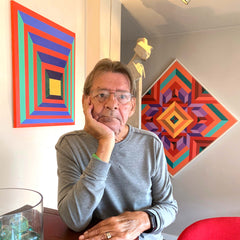
"Naming this piece 'Alicia' was sort of tongue-in-cheek and came to me when I completed the piece and hung it in a space next to the piano. I stepped back after hanging it and seeing the two together just spoke to me, 'A painting of seemingly keyboard keys hanging next to the piano... Alicia! Alicia Keys!'. It was definitely an 'aha!' moment. The original concept came to me while I was nosing around my head for something different to paint. in the following, I expose my typical thought process(s)... "Black. I should have a large black background. Bright colors on a black background. Brightly-colored, hard edge geometry on a black background. Don't hide the black. Okay. so small colored geometry. Unexpected. Do something unexpected. No, do several unexpected things in a small colored space. Large black painting and unexpected whatevers in a very small part of the black background. That's it." With that information, I moved to the concept phase. I had the brightly colored geometry placed where/how I wanted on the black. Now, that part was sort of unexpected, but I wanted more disruption, so I broke the white key and extended the blue one. Everything came together to my satisfaction. It's a minimalist piece with big impact."
- Rick Ruark
Interested in this original? Email info@artlifting.com to:
- speak with an art specialist
- request condition photos and/or framing quotes

Pittsburgh, PA
“Art is not boundary-driven. It doesn’t discriminate and therefore crosses all borders of humankind.”
Rick is a unique, concept-driven artist whose eye for shape and color is palpable. Born in Columbus, Ohio, Rick relocated to Pittsburgh, Pennsylvania where he lives today. With a career in advertising and graphic design, Rick was able to exercise his creativity daily. However, peripheral neuropathy and arthritis affected his ability to use his hands and began to change his ability to execute complex key combinations on the computer. Still full of creative energy, Rick transitioned into a full-time artist.
Making art is healing for Rick, both physically and emotionally. In April of 2020, Rick received a liver and kidney transplant after a 7-year wait for a donor match. From a physical standpoint, making art keeps him moving. He must stand when creating all of his art because he works from a laid-flat easel, which prompts him to move around the piece and sometimes lift or turn it. During months of transplant recovery, this was critical for working his legs, arms and regaining balance. Emotionally and psychologically, Rick says “Making art can take the focus away from negativity and transfer those resources to something more positive. It's not an escape from issues, just a pleasant break, or respite from them and helps me to regroup as well as grounding me. Making art is a great equalizer for my emotions.”
Those who know Rick and his work see him as a ‘disrupter’ or ‘interruptor’. Rick explains, “I interrupt the flow of the viewers’ eyes on the canvas with a color, a geometry change or placement. Sometimes these are very obvious and other times very subtle. People either see it right away, eventually, or not at all. I enjoy it when people feel there’s something not quite right, but can’t quite pinpoint it. Sometimes deviation is necessary for the success of a concept and on occasion, the deviation becomes a permanent layer in my processes.”
For Rick, rejection is his biggest influencer and motivator, because, as he explains, success is an end result that comes from the hard work one does after rejection. He feels that rejection only leads to a greater thoughtfulness in his creative processes and acknowledges the valid opinions of the viewer. He is influenced by the Haitian artists of Miami, whose color choices influence his today, as well as Frank Lloyd Wright whose homes with their long, horizontal lines were first to inspire his geometric pieces. Additionally, Rick appreciates the use of geometry of Bauhaus artists and architects, as well as the colors and geometry used by Victor Vaserely, Andy Warhol, and Frank Stella.
Overall, Rick says his greatest accomplishments would first be his two sons, both of whom have since passed. Rick goes on to say, “Second would be enjoying a successful professional career that I created on my own terms: a tremendous amount of self-teaching combined with the ability to relate to those layers of corporate America who believed in me and helped me along the way.” Rick beautifully summarizes why ArtLifting is valuable to him and others, when he says, “Artlifting breaks down that wall and reveals a display of talent and perseverance in individuals that, while they may have to work a little harder to produce their final result, accomplish it spectacularly. Artlifting gives these artists and creatives recognition for their accomplishments and legitimizes their work.”
ArtLifting champions artists impacted by disabilities and housing insecurity by connecting their art with socially-conscious customers . Learn more here.